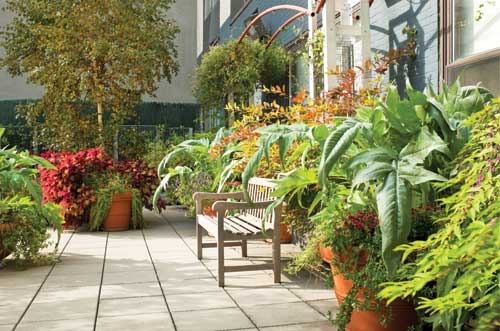
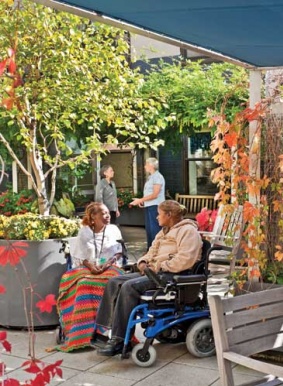
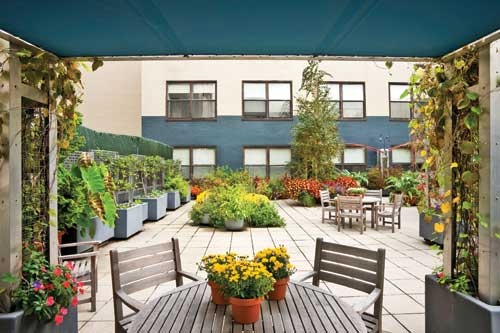
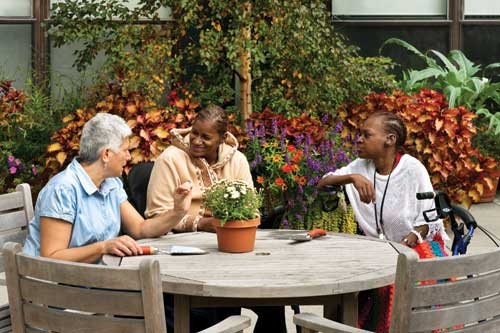
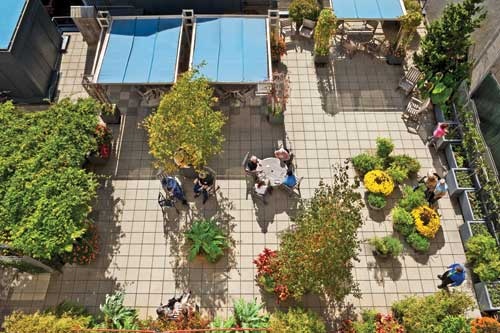
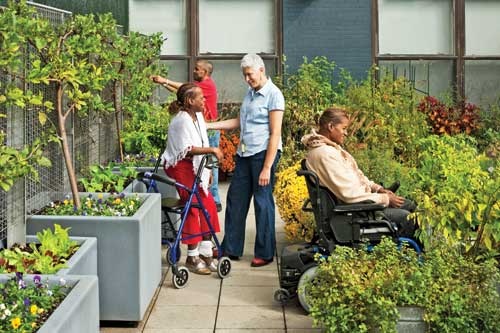
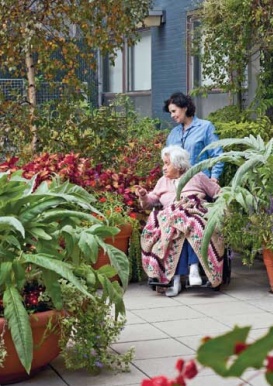
|
New York City, NY United States |
1249 5th Ave. | Joel Schnaper Memorial Garden |
since 1 December 1995 one name |
Deanna Medina, Dirtworks, PC
Located in the East Harlem community across from Central Park in New York City, the Terence Cardinal Cooke Health Care Center is a 729-bed continuing-care facility sponsored by the Roman Catholic Archdiocese of New York with a multitude of special care units and two large outpatient clinic.
Patients (residents) are lodged in either a private room or share a room. The Center’s Nursing Facility treats elderly patients and people with chronic illness or a variety of conditions, including stroke, respiratory and cardiac diseases, multiple sclerosis, cerebral palsy and dementia. Special units are dedicated to people living with Huntington’s Disease, those who suffer from Alzheimer’s or dementia, patients needing interim medical care, those living with end-stage renal failure and people with respiratory problems. In 1989, the center became the first long-term care skilled nursing facility in New York City to designate a unit to care for AIDS patients including those with HIV.
Hospitals and other health care facilities are not settings normally viewed with any sense of serenity or peace of mind. Healing can be painful and fraught with uncertainty. All is not doom and gloom, however.
Since 1995, the Joel Schnaper Memorial Garden on the roof of the Terence Cardinal Cooke Health Care Center has been an oasis of peace and tranquility for residents and visitors. The garden’s convenient location makes it ideal for small gatherings, ranging from parties to exercise classes.
The center’s rooftop garden welcomes all residents, visitors and staff and provides a therapeutic environment for the adjacent AIDS care wing. The garden, built totally with donations and volunteer labor, is dedicated to Joel Schnaper, a landscape architect specializing in urban gardens who died of AIDS.
The rooftop garden was designed pro-bono by David Kamp FASLA, LF, the founding principal of Dirtworks, PC. The therapeutic garden reflects the firm’s design philosophy: provide opportunities for people to connect with nature on their own terms, in their own way and at their own pace, regardless of their capabilities.
“We believe in the power of nature to enhance our everyday lives,” explains Mr. Kamp. “Our work is an ongoing study of the many ways we experience and reflect on nature, how it stimulates memory, the physical senses and the desire to be caretakers of the environment that nurtures us.”
In 2004, building upgrades necessitated that the garden be totally removed. Dirtworks, PC was asked to rebuild the garden to continue the Health Care Center’s vision and mission of care and to extend the life of the garden for decades of enjoyment.
David Kamp continues to be the garden’s steward to this day. In April 2010, the ArchCare/Terence Cardinal Cooke Health Care Center honored David with the Mary White Commitment Award. The award honors Mr. Kamp’s 15 years of sustained pro bono efforts on the garden.
Dirtworks, PC also received a 2010 Merit Award from the ASLA New York Chapter for the Joel Schnaper Memorial Garden. The judges noted the project demonstrates the effectiveness of gardens to influence and enhance a health care setting.
The Garden in Context
The garden’s design considerations reflect an approach that is sensitive to the changing needs of residents and staff and is flexible enough to accommodate changes. The success of this approach over time becomes apparent when put in the context of HIV/AIDS.
“The Schnaper Garden was a response to an emerging and largely unknown illness,” notes Mr. Kamp. “That uncertainty led to a design that employed simple basic principles of flexibility, opportunity and choice. Those principles have served the garden well over the years.”
Evidence-based design guidelines and basic medical protocols were scarce at the time of the garden’s inception 15 years ago. With few precedents to draw upon, the design work first entailed careful consultation with physicians and nurses to understand the progressive nature of the disease as was then known, and the effects of available medications and emerging treatments. Therapists were also consulted for ideas how their indoor activities could be incorporated into protective outdoor settings. Whenever possible, residents were also asked for their ideas for the garden.
Immediacy and Flexibility
What became apparent was the need for “immediacy.” Many residents were seriously ill and weakened. Their conditions changed daily, heightening a sense of isolation and vulnerability. Many could only see the garden from their adjoining rooms. Changing individual conditions and varying medical protocols demanded very individualized approaches, which were reflected in the garden’s opportunities and choices.
Flexibility was equally important, as medical knowledge about HIV/AIDS increased and new medications prolonged life. Residents grew stronger and their stamina increased, as did the number of residents able to use the garden and the number and variety of activities within it. The garden became a favored destination for residents and staff in the entire facility. The various spaces were modified to address the changing needs of patients and will continue to evolve as treatment for HIV/AIDS advances.
The value of the garden’s therapeutic benefits increased not only among residents and staff, but with the hospital’s administration. In 2005, when the roof’s 20-year old waterproofing membrane needed replacement, the decision was made to rebuild the garden using more expensive and durable materials to insure the garden would endure for 25 years. The basic design and the basic premise of sensitivity and flexibility remain intact.
Photos (C) Dirtworks, PC LandscapeOnline.com
15 April 2010
Stephen Kelly, New York City


















